Mingze Li
Group Sequence Policy Optimization
Jul 24, 2025Abstract:This paper introduces Group Sequence Policy Optimization (GSPO), our stable, efficient, and performant reinforcement learning algorithm for training large language models. Unlike previous algorithms that adopt token-level importance ratios, GSPO defines the importance ratio based on sequence likelihood and performs sequence-level clipping, rewarding, and optimization. We demonstrate that GSPO achieves superior training efficiency and performance compared to the GRPO algorithm, notably stabilizes Mixture-of-Experts (MoE) RL training, and has the potential for simplifying the design of RL infrastructure. These merits of GSPO have contributed to the remarkable improvements in the latest Qwen3 models.
STAR-R1: Spatial TrAnsformation Reasoning by Reinforcing Multimodal LLMs
May 26, 2025Abstract:Multimodal Large Language Models (MLLMs) have demonstrated remarkable capabilities across diverse tasks, yet they lag significantly behind humans in spatial reasoning. We investigate this gap through Transformation-Driven Visual Reasoning (TVR), a challenging task requiring identification of object transformations across images under varying viewpoints. While traditional Supervised Fine-Tuning (SFT) fails to generate coherent reasoning paths in cross-view settings, sparse-reward Reinforcement Learning (RL) suffers from inefficient exploration and slow convergence. To address these limitations, we propose STAR-R1, a novel framework that integrates a single-stage RL paradigm with a fine-grained reward mechanism tailored for TVR. Specifically, STAR-R1 rewards partial correctness while penalizing excessive enumeration and passive inaction, enabling efficient exploration and precise reasoning. Comprehensive evaluations demonstrate that STAR-R1 achieves state-of-the-art performance across all 11 metrics, outperforming SFT by 23% in cross-view scenarios. Further analysis reveals STAR-R1's anthropomorphic behavior and highlights its unique ability to compare all objects for improving spatial reasoning. Our work provides critical insights in advancing the research of MLLMs and reasoning models. The codes, model weights, and data will be publicly available at https://github.com/zongzhao23/STAR-R1.
STAR-R1: Spacial TrAnsformation Reasoning by Reinforcing Multimodal LLMs
May 21, 2025Abstract:Multimodal Large Language Models (MLLMs) have demonstrated remarkable capabilities across diverse tasks, yet they lag significantly behind humans in spatial reasoning. We investigate this gap through Transformation-Driven Visual Reasoning (TVR), a challenging task requiring identification of object transformations across images under varying viewpoints. While traditional Supervised Fine-Tuning (SFT) fails to generate coherent reasoning paths in cross-view settings, sparse-reward Reinforcement Learning (RL) suffers from inefficient exploration and slow convergence. To address these limitations, we propose STAR-R1, a novel framework that integrates a single-stage RL paradigm with a fine-grained reward mechanism tailored for TVR. Specifically, STAR-R1 rewards partial correctness while penalizing excessive enumeration and passive inaction, enabling efficient exploration and precise reasoning. Comprehensive evaluations demonstrate that STAR-R1 achieves state-of-the-art performance across all 11 metrics, outperforming SFT by 23% in cross-view scenarios. Further analysis reveals STAR-R1's anthropomorphic behavior and highlights its unique ability to compare all objects for improving spatial reasoning. Our work provides critical insights in advancing the research of MLLMs and reasoning models. The codes, model weights, and data will be publicly available at https://github.com/zongzhao23/STAR-R1.
Qwen3 Technical Report
May 14, 2025
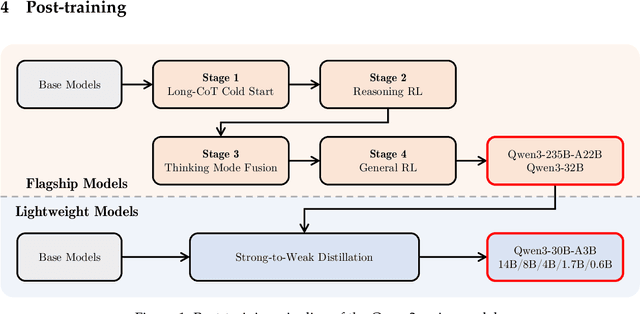

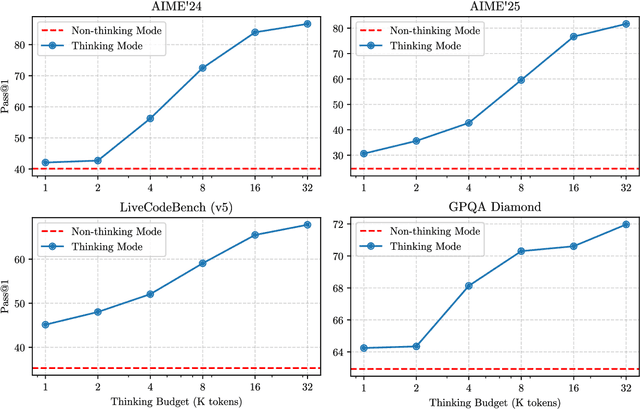
Abstract:In this work, we present Qwen3, the latest version of the Qwen model family. Qwen3 comprises a series of large language models (LLMs) designed to advance performance, efficiency, and multilingual capabilities. The Qwen3 series includes models of both dense and Mixture-of-Expert (MoE) architectures, with parameter scales ranging from 0.6 to 235 billion. A key innovation in Qwen3 is the integration of thinking mode (for complex, multi-step reasoning) and non-thinking mode (for rapid, context-driven responses) into a unified framework. This eliminates the need to switch between different models--such as chat-optimized models (e.g., GPT-4o) and dedicated reasoning models (e.g., QwQ-32B)--and enables dynamic mode switching based on user queries or chat templates. Meanwhile, Qwen3 introduces a thinking budget mechanism, allowing users to allocate computational resources adaptively during inference, thereby balancing latency and performance based on task complexity. Moreover, by leveraging the knowledge from the flagship models, we significantly reduce the computational resources required to build smaller-scale models, while ensuring their highly competitive performance. Empirical evaluations demonstrate that Qwen3 achieves state-of-the-art results across diverse benchmarks, including tasks in code generation, mathematical reasoning, agent tasks, etc., competitive against larger MoE models and proprietary models. Compared to its predecessor Qwen2.5, Qwen3 expands multilingual support from 29 to 119 languages and dialects, enhancing global accessibility through improved cross-lingual understanding and generation capabilities. To facilitate reproducibility and community-driven research and development, all Qwen3 models are publicly accessible under Apache 2.0.
A MEMS-based terahertz broadband beam steering technique
Sep 06, 2024Abstract:A multi-level tunable reflection array wide-angle beam scanning method is proposed to address the limited bandwidth and small scanning angle issues of current terahertz beam scanning technology. In this method, a focusing lens and its array are used to achieve terahertz wave spatial beam control, and MEMS mirrors and their arrays are used to achieve wide-angle beam scanning. The 1~3 order terahertz MEMS beam scanning system designed based on this method can extend the mechanical scanning angle of MEMS mirrors by 2~6 times, when tested and verified using an electromagnetic MEMS mirror with a 7mm optical aperture and a scanning angle of 15{\deg} and a D-band terahertz signal source. The experiment shows that the operating bandwidth of the first-order terahertz MEMS beam scanning system is better than 40GHz, the continuous beam scanning angle is about 30{\deg}, the continuous beam scanning cycle response time is about 1.1ms, and the antenna gain is better than 15dBi at 160GHz. This method has been validated for its large bandwidth and scalable scanning angle, and has potential application prospects in terahertz dynamic communication, detection radar, scanning imaging, and other fields.
MSceneSpeech: A Multi-Scene Speech Dataset For Expressive Speech Synthesis
Jul 19, 2024



Abstract:We introduce an open source high-quality Mandarin TTS dataset MSceneSpeech (Multiple Scene Speech Dataset), which is intended to provide resources for expressive speech synthesis. MSceneSpeech comprises numerous audio recordings and texts performed and recorded according to daily life scenarios. Each scenario includes multiple speakers and a diverse range of prosodic styles, making it suitable for speech synthesis that entails multi-speaker style and prosody modeling. We have established a robust baseline, through the prompting mechanism, that can effectively synthesize speech characterized by both user-specific timbre and scene-specific prosody with arbitrary text input. The open source MSceneSpeech Dataset and audio samples of our baseline are available at https://speechai-demo.github.io/MSceneSpeech/.
AudioGPT: Understanding and Generating Speech, Music, Sound, and Talking Head
Apr 25, 2023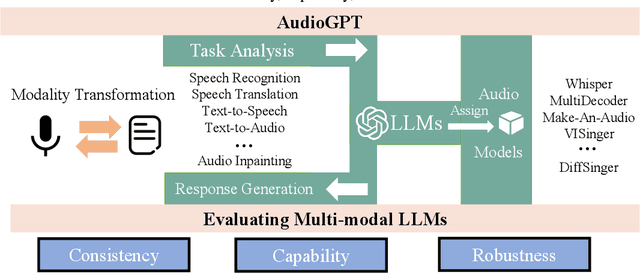
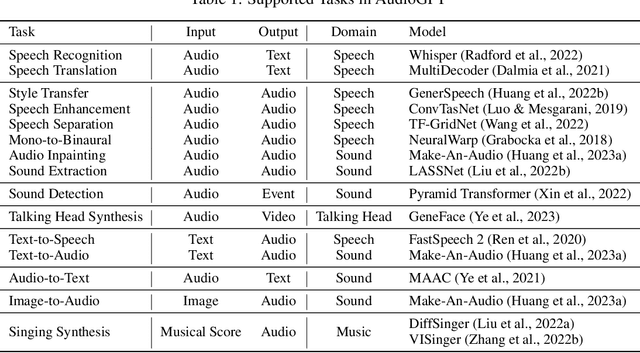


Abstract:Large language models (LLMs) have exhibited remarkable capabilities across a variety of domains and tasks, challenging our understanding of learning and cognition. Despite the recent success, current LLMs are not capable of processing complex audio information or conducting spoken conversations (like Siri or Alexa). In this work, we propose a multi-modal AI system named AudioGPT, which complements LLMs (i.e., ChatGPT) with 1) foundation models to process complex audio information and solve numerous understanding and generation tasks; and 2) the input/output interface (ASR, TTS) to support spoken dialogue. With an increasing demand to evaluate multi-modal LLMs of human intention understanding and cooperation with foundation models, we outline the principles and processes and test AudioGPT in terms of consistency, capability, and robustness. Experimental results demonstrate the capabilities of AudioGPT in solving AI tasks with speech, music, sound, and talking head understanding and generation in multi-round dialogues, which empower humans to create rich and diverse audio content with unprecedented ease. Our system is publicly available at \url{https://github.com/AIGC-Audio/AudioGPT}.
Robust Table Structure Recognition with Dynamic Queries Enhanced Detection Transformer
Mar 21, 2023Abstract:We present a new table structure recognition (TSR) approach, called TSRFormer, to robustly recognizing the structures of complex tables with geometrical distortions from various table images. Unlike previous methods, we formulate table separation line prediction as a line regression problem instead of an image segmentation problem and propose a new two-stage dynamic queries enhanced DETR based separation line regression approach, named DQ-DETR, to predict separation lines from table images directly. Compared to Vallina DETR, we propose three improvements in DQ-DETR to make the two-stage DETR framework work efficiently and effectively for the separation line prediction task: 1) A new query design, named Dynamic Query, to decouple single line query into separable point queries which could intuitively improve the localization accuracy for regression tasks; 2) A dynamic queries based progressive line regression approach to progressively regressing points on the line which further enhances localization accuracy for distorted tables; 3) A prior-enhanced matching strategy to solve the slow convergence issue of DETR. After separation line prediction, a simple relation network based cell merging module is used to recover spanning cells. With these new techniques, our TSRFormer achieves state-of-the-art performance on several benchmark datasets, including SciTSR, PubTabNet, WTW and FinTabNet. Furthermore, we have validated the robustness and high localization accuracy of our approach to tables with complex structures, borderless cells, large blank spaces, empty or spanning cells as well as distorted or even curved shapes on a more challenging real-world in-house dataset.
Make-An-Audio: Text-To-Audio Generation with Prompt-Enhanced Diffusion Models
Jan 30, 2023Abstract:Large-scale multimodal generative modeling has created milestones in text-to-image and text-to-video generation. Its application to audio still lags behind for two main reasons: the lack of large-scale datasets with high-quality text-audio pairs, and the complexity of modeling long continuous audio data. In this work, we propose Make-An-Audio with a prompt-enhanced diffusion model that addresses these gaps by 1) introducing pseudo prompt enhancement with a distill-then-reprogram approach, it alleviates data scarcity with orders of magnitude concept compositions by using language-free audios; 2) leveraging spectrogram autoencoder to predict the self-supervised audio representation instead of waveforms. Together with robust contrastive language-audio pretraining (CLAP) representations, Make-An-Audio achieves state-of-the-art results in both objective and subjective benchmark evaluation. Moreover, we present its controllability and generalization for X-to-Audio with "No Modality Left Behind", for the first time unlocking the ability to generate high-definition, high-fidelity audios given a user-defined modality input. Audio samples are available at https://Text-to-Audio.github.io
TSRFormer: Table Structure Recognition with Transformers
Aug 09, 2022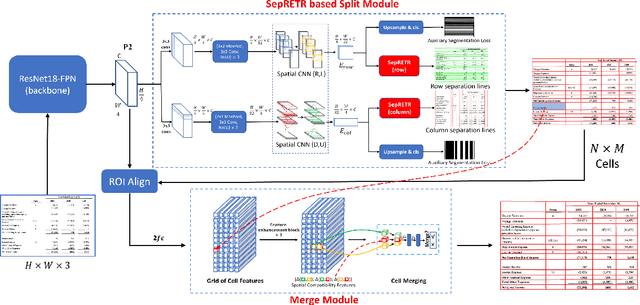
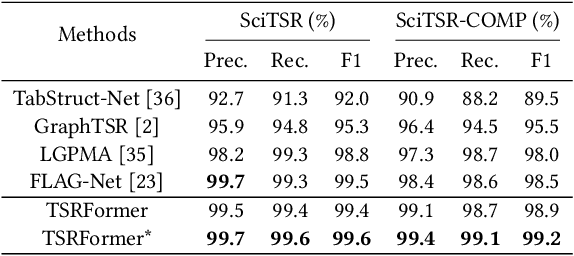
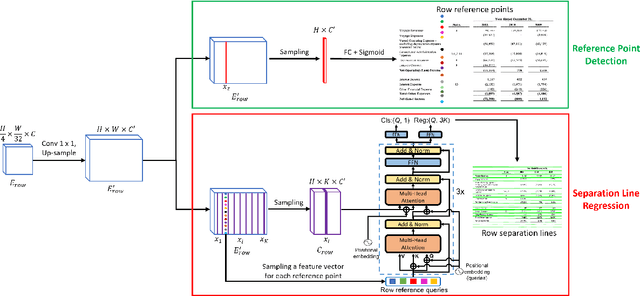

Abstract:We present a new table structure recognition (TSR) approach, called TSRFormer, to robustly recognizing the structures of complex tables with geometrical distortions from various table images. Unlike previous methods, we formulate table separation line prediction as a line regression problem instead of an image segmentation problem and propose a new two-stage DETR based separator prediction approach, dubbed \textbf{Sep}arator \textbf{RE}gression \textbf{TR}ansformer (SepRETR), to predict separation lines from table images directly. To make the two-stage DETR framework work efficiently and effectively for the separation line prediction task, we propose two improvements: 1) A prior-enhanced matching strategy to solve the slow convergence issue of DETR; 2) A new cross attention module to sample features from a high-resolution convolutional feature map directly so that high localization accuracy is achieved with low computational cost. After separation line prediction, a simple relation network based cell merging module is used to recover spanning cells. With these new techniques, our TSRFormer achieves state-of-the-art performance on several benchmark datasets, including SciTSR, PubTabNet and WTW. Furthermore, we have validated the robustness of our approach to tables with complex structures, borderless cells, large blank spaces, empty or spanning cells as well as distorted or even curved shapes on a more challenging real-world in-house dataset.
 Add to Chrome
Add to Chrome Add to Firefox
Add to Firefox Add to Edge
Add to Edge